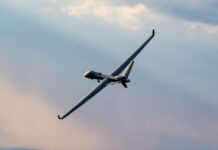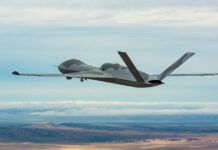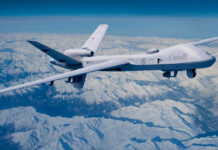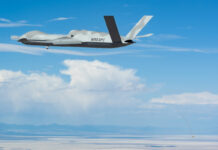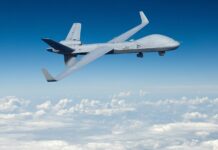A General Atomics Aeronautical Systems Inc (GA-ASI) MQ-9B SeaGuardian unmanned aircraft system was used to support the US Navy’s ‘Northern Edge 2023’ (NE23) exercise from 6 to 19 May 2023, the company reported on 7 June.
The training exercise, which took place in the Gulf of Alaska, was one of a series of US Indo-Pacific Command (IPACOM) exercises that prepares joint forces to respond to crises in the Asia Pacific region.
During NE23 a SeaGuardian unmanned aerial vehicle (UAV) provided real-time maritime intelligence, surveillance, reconnaissance and targeting (ISR&T) data feeds to various IPACOM operations centres including, Pacific Fleet, Pacific Air Forces, Joint Base Elmendorf-Richardson Joint Exercise Control Group (JECG) and various exercise and real-world watch floors. Real-time sensor data – including signals intelligence (SIGINT), radar, and full-motion video – was processed, exploited and disseminated by operators via Minotaur Mission System. Developed by the Johns Hopkins University Applied Physics Laboratory, the Minotaur system links sensors, SIGINT, cameras, radar and communications equipment into a single, automated system that allows operators to more efficiently identify, track and target simultaneously with other users for expedited dynamic tasking. This classified data was transmitted to the Joint Fires Network using new technologies allowing for the smart routing of communications between widely distributed communications nodes.
In addition, the SeaGuardian UAV, a maritime derivative of the MQ-9B SkyGuardian, showcased an array of operational payloads, including electronic support measures (ESM), radar moving-target indication (MTI) and inverse synthetic-aperture radar (ISAR), communications intelligence (COMINT), an Automatic Identification System (AIS), a high-definition electro-optical/infra-red (EO/IR) imaging system and a Link 16 datalink.
The ESM payload was supplied by Sierra Nevada Corporation, the COMINT payload was produced by L3Harris Technologies, while Raytheon Technologies provided the UAV’s SeaVue multi-role radar. GA-ASI’s Link 16 solution leveraged the L3Harris Small Tactical Terminal KOR-24A radio, Ultra Electronics Air Defense Systems Integrator host software ran on the UAV’s Parry Labs Stellar Relay Common Compute Module.
A GA-ASI-developed detect-and-avoid system was also installed in the SeaGuardian and received a limited certification from US Naval Air Systems Command. This enabled the SeaGuardian to perform beyond-visual line-of-sight (BVLOS) operations within the exercise airspace.

In addition to its contributions to the exercise, the SeaGuardian UAV self-deployed from GA-ASI’s Desert Horizons flight operations facility in El Mirage, California, to Joint Base Elmendorf-Richardson in Alaska, covering over 2,000 nautical miles in a single flight. The aircraft also self-deployed back to El Mirage following the exercise. All flights were controlled from a forward-deployed mission command element comprising a certified ground control station and mission intelligence station located at Naval Air Station Whidbey Island in Washington state.
The SeaGuardian deployment for NE23 adds to previous recent experience the US Navy has with the system. In April an MQ-9B was deployed by GA-ASI to support the navy’s Group Sail Exercise help in Hawaiian military operating areas, where it conducted tasks related to maritime ISR, anti-submarine warfare, long-range fires, and simulated battle damage assessment in concert with navy ships and aircraft.
In August 2022 a SeaGuardian was also involved in the US Navy’s ‘Rim of the Pacific’ (RIMPAC) exercise, conducted in and around the Hawaiian Islands and southern California.
Peter Felstead




